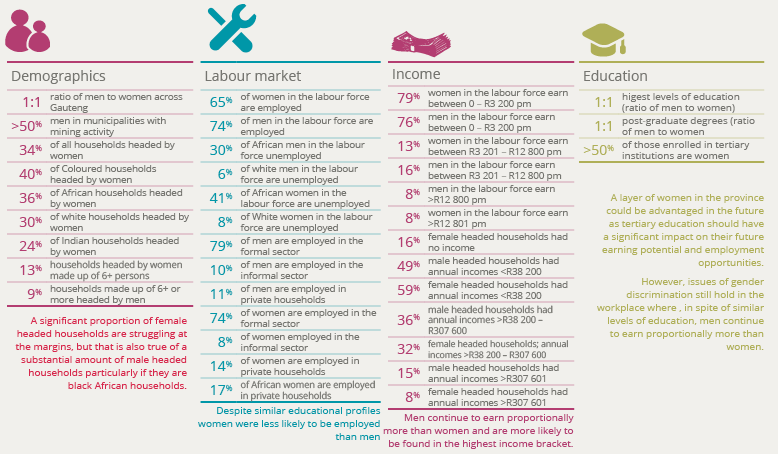While men and women live in the same spaces in the GCR, their experiences of living in the city-region can be different. Experiences are also shaped by race and class. Overall, the ratio of men to women in the province is 50:50, but men and women are not distributed evenly across municipalities. Municipalities such as Midvaal, Lesedi, Mogale City, Westonaria, Merafong and Ekurhuleni have a higher proportion of men than women in their populations. This is likely to reflect migration into these municipalities particularly, in the most imbalanced, e.g. Westonaria (55% male) and Merafong (54% male), whose economies are based on mining. Similar dynamics can be seen in the platinum belt of Rustenburg where men constitute 55% of the population.
Census 2011 found that over a third (34%) of households in Gauteng were headed by women and a similar proportion of male and female headed households consisted of one person (30% and 29%, respectively). A higher proportion of female (13%) compared to male (9%) headed households were made up of 6 persons or more, indicating that they may be carrying the load of caring for children of family members. Census 2011 showed that the profiles of men and women in Gauteng by the highest level of education achieved are similar.However, the 2010 enrolment figures for tertiary institutions in Gauteng reveal that women outnumber men across all race groups. It was only at Vaal University of Technology that men outnumbered women. This raises questions for the future earning and employment potential of men and women in the province. Despite their educational profiles, Census 2011 found that women were less likely to be employed than men (65% compared to 74%) and 26% of men and 35% of women in the labour market were unemployed or discouraged work seekers. Race made a difference, with higher proportions of Black African men and women being unemployed than any other race group. Overall, Census 2011 found that of those who were employed Black African men and women were least likely to work in the formal sector and most likely to be employed in private households.
Despite seeming to have similar levels of education as men, women in the province do not earn earn at the same level. As individuals, Census 2011 found a higher proportion of women had no income, were equally likely to have incomes below R3,200 pm but were less likely to be found in higher income brackets. This was particularly true for Black African women. This may indicate that a higher proportion of women work in lower paid sectors of employment. However, it should be noted that the biggest predictor of income levels appears to be race combined with sex.





